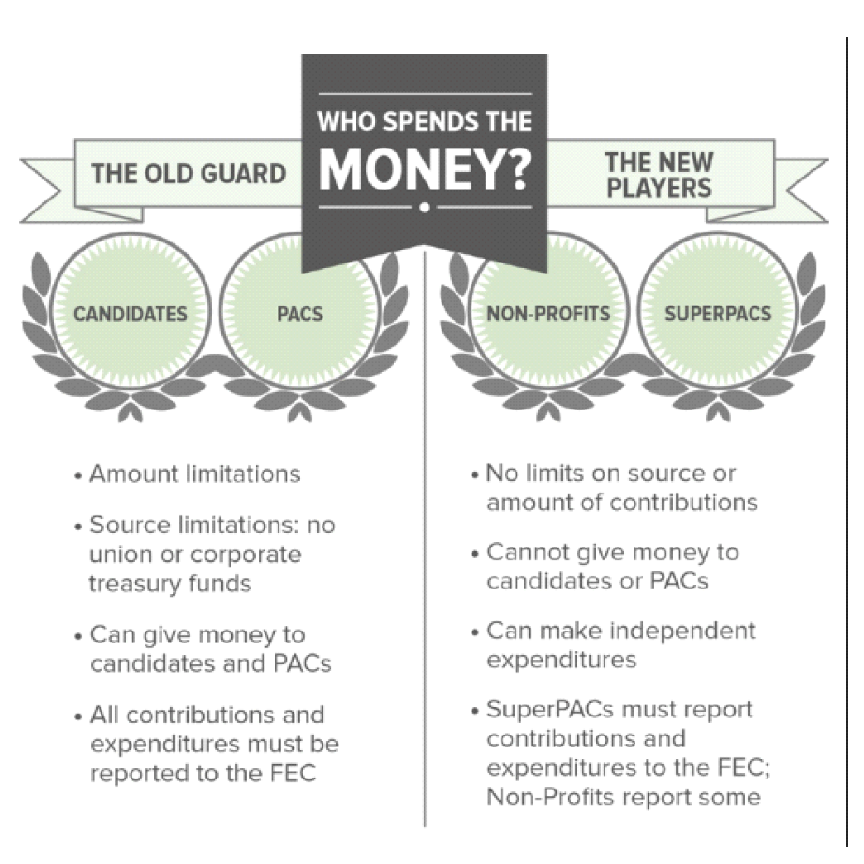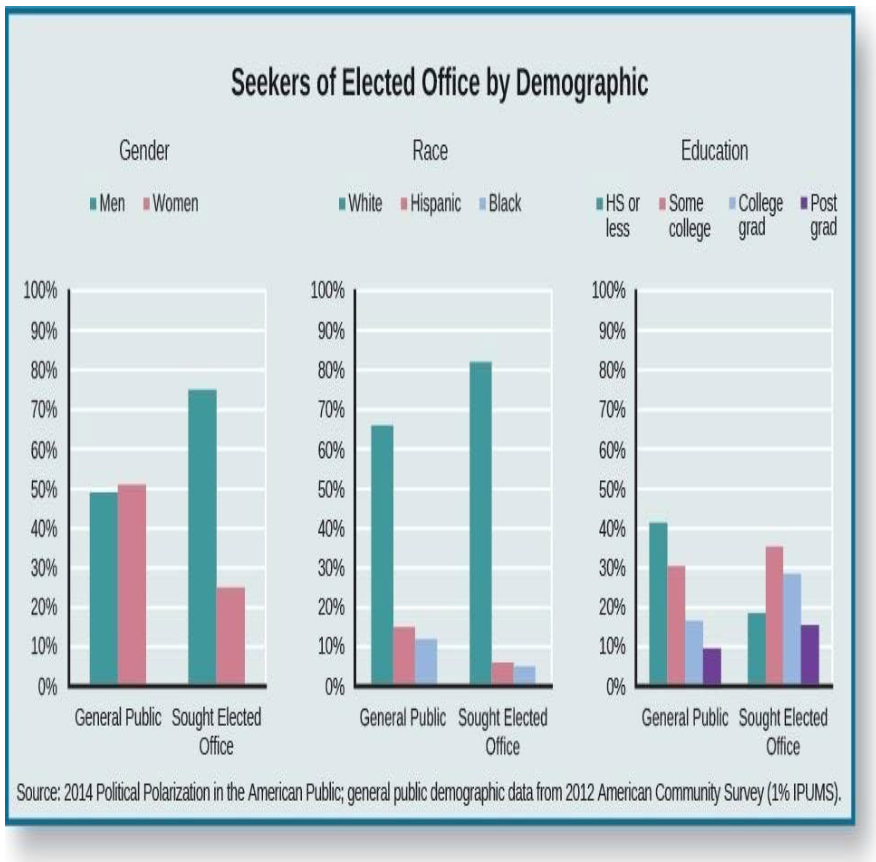5.5: Campaigns in Texas
- Page ID
- 129161
In states like Texas everything is bigger, including campaign funds. Governor Greg Abbott raised 43.3 million dollars in 2018 to keep his seat!
Part of Beto’s success in 2018 was also due to his ability to raise huge amounts of money for his campaign. He set a record by raising over eighty million dollars! What was most impressive in that race was that until the end Beto did not receive money from Political Action Committees, also known as PACS. Political Action Committees (PACs) are vehicles for amassing funds, which are then spent on strategic actions their leaders hope will influence elections. On March 6, 2018, in an interview on HBO's "Real Time With Bill Maher," Beto explained why he chose not to accept any money from PACs in his run for Senate:
So, political action committees represent the corporations and interests that have business before Congress—so the pharmaceutical industries, the telecom industries, the energy industries, the insurance industries—and they give money to members of Congress not just for access, although that’s part of it. They’re also buying outcomes, actual legislative language that appears in the bills, and in the bills that become laws.38
O’Rourke goes on to say, "When you wonder why Congress is so dysfunctional, why it doesn’t represent the interests of the people it purports to serve, it’s because it’s so tied to the sources of
money that are coming in."39 Since his House bid in 2014, Beto has not accepted any PAC donations and has run his campaigns on individual donors. There is much speculation that in 2022 Beto will challenge Abbott for the governorship, and it will be interesting to see if he sticks to his guns when it comes to PAC money against a big donor recipient like Abbott.
The goal of any campaign is to get the candidate’s name out to the public because if the voters have not heard of you then they are not going to vote for you. So, name identification matters. If you are a candidate, you must also motivate people to vote for you, which in Texas is an uphill battle, given Texas’s historically low voter turnout, especially in a non-presidential election (midterm election).
Beto has been described as a charismatic character and Democrats around the United States showed their support, but Beto really mobilized young voters through informal campaigning. Informal campaigning includes canvassing voters door to door and speaking at local events like barbeques, churches, or rodeos. Through his Instagram and Twitter posts Beto connected with college voters. College age voters are a group that is eligible to vote but often choose to stay home and not vote. Beto went to numerous college campuses in Texas throughout his campaign to speak directly to young voters and garner their support. If you followed Beto on Instagram you were able to really get an insight into his life. He even put his dental visit on social media!
Still, in order to win a general election, you need more than an informal campaign. You need a team of people and a lot of money. The bigger the race the more money usually spent to try to win, and in Texas, the candidate who spends the most money usually wins the race. While the average donor gives less than $200, Texas is a big money state. In fact, Texans give more money to campaigns than any other state! Texas has two cities in the top five for campaign donations: Dallas and Houston. And megadonors like those listed as Governor Abbott’s largest donors are really financing the bulk of a campaign (Table 5.2). So, does that mean that megadonors like S. Javaid Anwar, the President of Midland Energy (who donated one million dollars), or James Doug Pitcock, the CEO of Williams Brothers Construction Co.—the largest highway construction company in Texas (and who donated $550, 000 to a “Texans for Greg Abbott” PAC and gave $250,000 to his inauguration)—have a bigger say in our democracy?
| Donors | Type | Total Donations |
|---|---|---|
| James D. Pitcock, Jr. | Individual | $1,0510.050.00 |
| S. Javaid Anwar | Individual | 1,013,300.00 |
| Michael and Mary Porter | Individual | 1,000,000.00 |
| Kenny A. and Lisa Troutt | Individual | 650,000.00 |
| Arch Aplin III | Individual | 500,000.00 |
| Edward Roski, Jr. | Individual | 500,000.00 |
| R. Drayton McLane, Jr. | Individual | 500,000.00 |
| William Harris | Individual | 400,000.00 |
| Paul L. Foster | Individual | 391,864.45 |
| Robert C. and Pamela | Individual | 375,000.00 |
Another source for amassing campaign funds is Super PACs. Super PACs came into play in 2010 with the U.S. Supreme Court’s decision in Citizens United v. Federal Election Commission (FEC), which made it much easier for people and organizations to donate anonymously to campaigns. The ruling let individuals, unions, and corporations donate on a large scale to political action committees. Donating to campaigns and donating to PACs or Super PACs are different and have different rules, and prior to Citizens United, individuals, unions, and corporations were forbidden to donate amounts over a paltry $5,000 to a PAC. Something to keep in mind, however, is that in Texas individuals can donate an unlimited amount to campaigns as long as it is disclosed. Texas is only one of eleven states to have this rule. However, after Citizens United a company like Walmart, or Texas’s Pizza Hut or Dell, could pour unlimited amounts into political action committees anonymously (Figure 5.20). Texas leads the nation in donations to Super PACs. Texans have donated far more money to Super PACs than voters from any other state, the vast majority of it going to conservative and Republican political committees.

So, where does all the money amassed by Super PACs go? Well, most of it goes to negative campaign advertisements that you see on the television. For candidates who have a bigger budget, formal campaigning involves television advertising and other media outlets, (newspapers, radio, websites, social media) as well as conducting polls and surveys of
voters. Polls are conducted in order to determine what the public supports and what it doesn’t. It is a way for campaigns and representatives to understand what the voters want. Polls are often conducted by simple phone calls. People are randomly selected which means that every person in the population has an equal chance of being selected this is called a random sample. When conducting a poll, you need to have a big enough sample size to accurately represent the population, meaning you must ask enough people the same set of questions. Public opinion polling is heavily used by campaigns to help determine what voters want and what can be done to change their vote. If their vote cannot be changed, then the goal is to make them stay home and not vote.
Fear and anger are powerful emotions and negative attack ads are designed to trigger those emotions. But why? Well, if you are a staunch Democrat or Republican and you see an ad that makes your preferred candidate look bad are you really going to switch parties? No, you will not. But if the opposing party can make your candidate look bad enough, you might stay home and not vote. So, negative campaign ads serve a few useful functions. One, they trigger a powerful response to motivate you to vote against the candidate that is portrayed as being bad in the ad. Two, they help independents decide who to vote for by giving them information. Finally, they might make people stay home and not vote if their candidate has been made to look very badly. Some examples of negative campaign include the Presidential Lyndon Johnson-Barry Goldwater 1964 Daisy ad, which invoked potential nuclear devastation. This Daisy attack ad was so powerful it only aired once but helped Johnson achieve one of the biggest landslide victories in U.S. history!
Campaign ads do not have to be negative. Many campaigns try to piggyback on presidential popularity to gain votes. Likening yourself to a popular president in your state or receiving support from others in higher office in your state can often boost you in the polls. In the Republican primary in 2020 between Kathleen Wall and Troy Niehls, Wall tried to cash in on Texas’s support for Trump by likening herself to him even down to her hair, though Niehls ultimately won the seat for Texas’s Twenty-Second Congressional District.
The opposite can also be true, negative campaign ad run by an Abbott PAC likened Democrat Wendy Davis to then President Obama to her detriment here in Texas. In this ad, Abbott claimed Davis was “just like Obama.”40 Governor Abbott bought 251 hours of air time compared with Davis’s 105 and won the state by double digits.41
Many criticize Super PACs by saying that it allows the wealthy to have a bigger voice and anonymously. Critics also say that negative campaign ads are detrimental because they distort the truth. What do you think? Are Super PACs so super? So, do mega-donations that mean that megadonors like S. Javaid Anwar, the President of Midland Energy (who donated one million dollars), or James Doug Pitcock, the CEO of Williams Brothers Construction Co.—the largest highway construction company in Texas (and who donated $550, 000 to a “Texans for Greg Abbott” PAC and gave $250,000 to his inauguration)—have a bigger say in our democracy? The vast amounts of money spent on campaigns in Texas leads many to say that Texas is a Pay to Play state where those who have money and can donate to campaigns often through PACs have a bigger voice.
The Path to Nomination
Running for office in Texas can be as easy as collecting one hundred signatures on a city election form or paying a registration fee of several thousand dollars to run for governor of the state. However, a potential candidate still needs to meet state-specific requirements covering length of residency, voting status, and age.
Deciding to Run
Potential candidates must also consider competitors, family obligations, and the likelihood of drawing financial backing. Spouses, children, work history, health, financial history, and business dealings also become part of the media’s focus, along with many other personal details about the past. The realities of elections drive many eligible and desirable candidates away from running.
Seekers of Elected Office by Demographic
Candidates for office are slightly less diverse than the general population, as is seen in Figure 5.21. A lack of diversity includes gender. Dramatically fewer women run than men. Studies have shown that family obligations rather than desire or ambition account for this choice. Further, women are more likely than men to wait until their children are older before entering politics, and women say that they struggle to balance campaigning and their workload with parenthood.44

Because higher office is often attained only after service in lower office, there are repercussions to women for waiting so long. If they do decide to run for the U.S. House of Representatives or Senate, they are often older, and fewer in number, than their male colleagues.
38. Bill Maher, host, “Real Time with Bill Maher” (Beto O’Rourke interview), March 6, 2018, https://www.politifact.com/factcheck...pac-donations/.
39. “Real Time with Bill Maher” (Beto O’Rourke interview), https://www.politifact.com/factcheck...pac-donations/.
40. Christine Ayala and Bobby Blanchard, “In Ad Spending, Greg Abbott Opens Big Margin,” New York Times, Oct. 23, 2014, https://www.nytimes.com/2014/10/24/u...-in-texas.html.
41. Ayala and Blanchard, “Abbott Ad Spending,” https://www.nytimes.com/2014/10/24/u...-in-texas.html.
44. McCullough, “Straight-Ticket Voting,” https://www.texastribune.org/2017/06...ticket-voting/.

